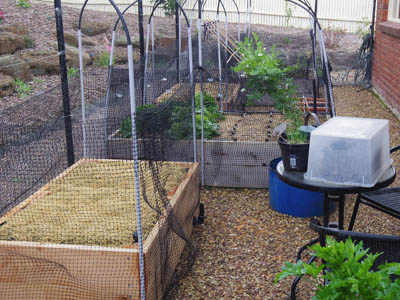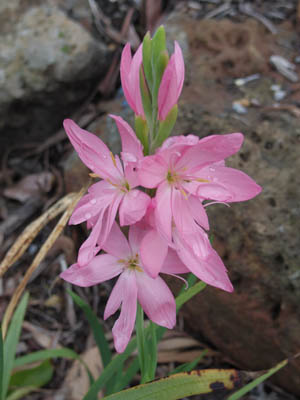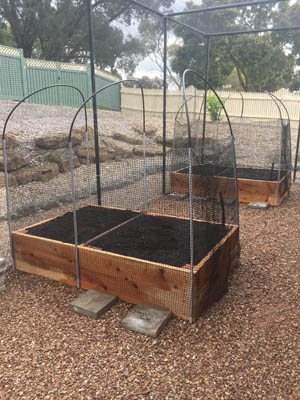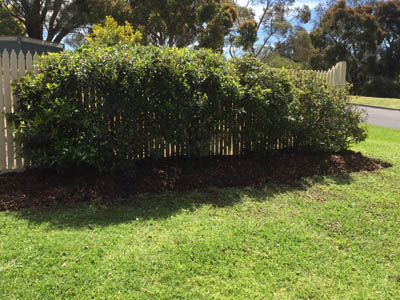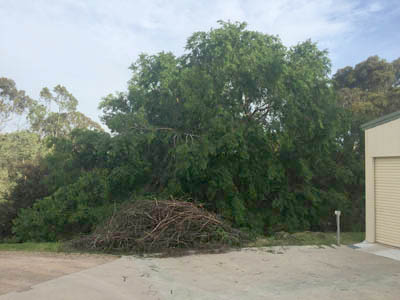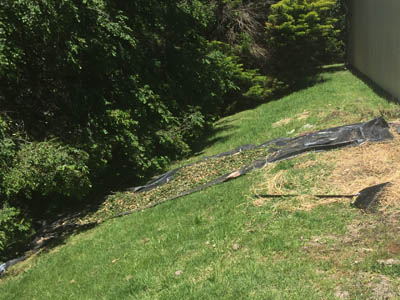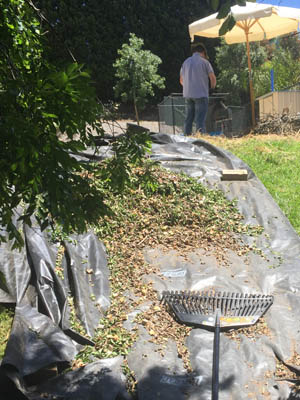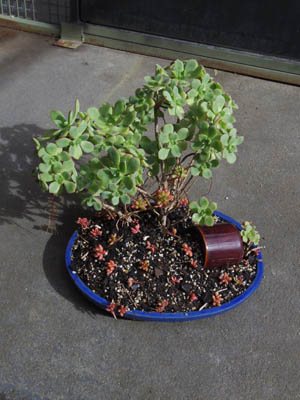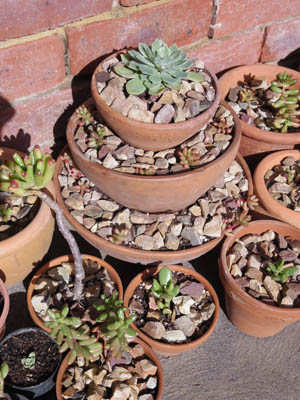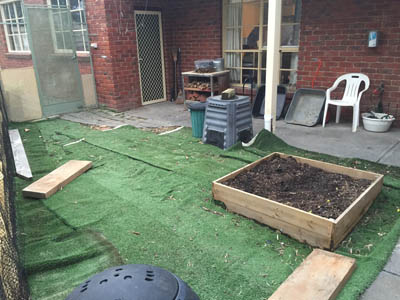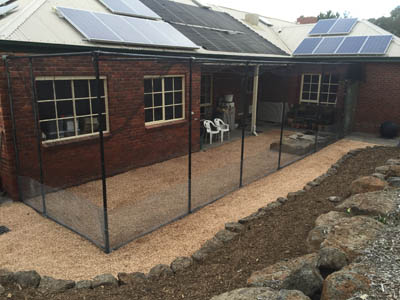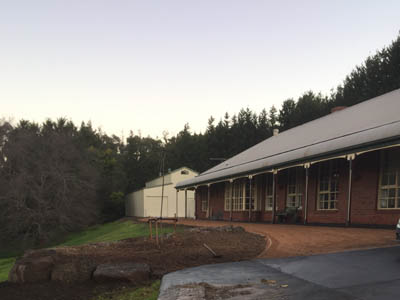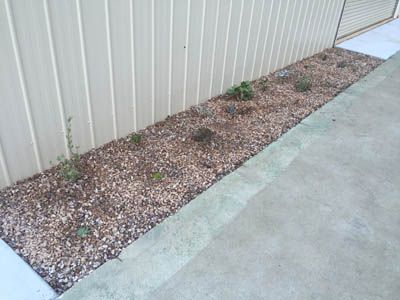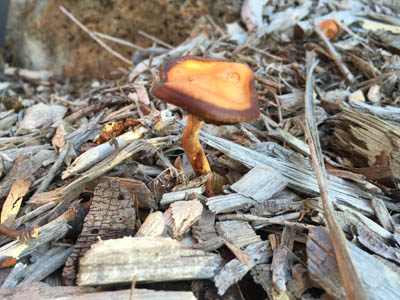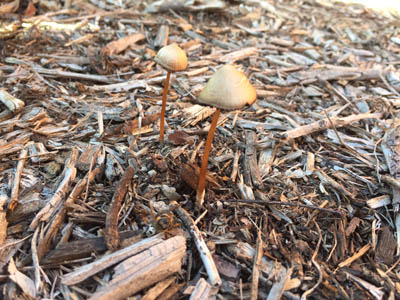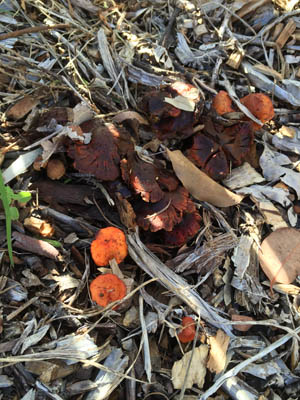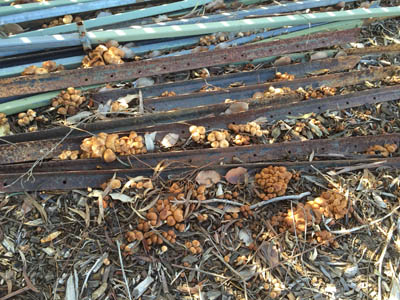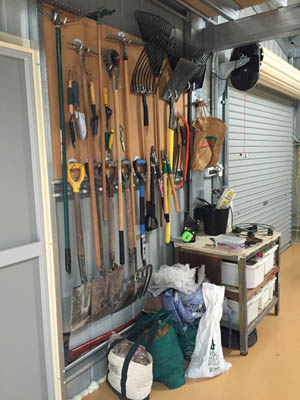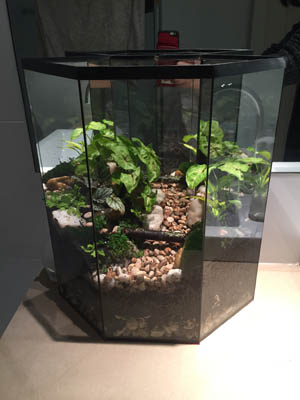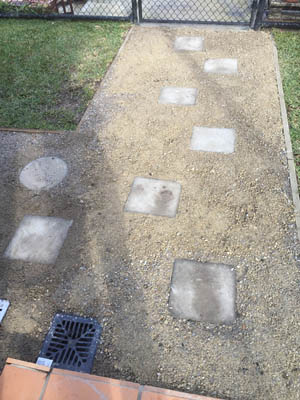I visited Cloudehill Gardens in the Dandenongs for the first time last year. It occurred to me afterwards that, while it’s a lot larger and more elaborate than my garden, the lie of the land is has similarities. Mine is also a tiered slope, though it faces east not south. Cloudehill also has its buildings on the middle-to-top tier, like mine. Their practical gardens are higher up while decorative ones are lower, as they are in mine… sort of.
Every corner of Cloudehill has a purpose or theme. It got me thinking about some of the ‘dead’ zones here. While weeding the upper embankment a few months back I paused to rest and realised it was a nice place to sit and look down on our yard. Since then I’ve been thinking of putting some kind of rustic seat up there.
I bought Jackie French’s “Backyard Sustainability” at Cloudehill’s garden shop and read-skimmed it over the following weekend. (You know, where you skip the bits not relevant to your climate/garden/ambitions.) I’ve been filled with inspiration and enthusiasm for growing food plants since. Growing more food plants, that is.
After looking through my gardening scrapbook, updating my garden plan on the computer, and plotting future projects, I made some changes to my garden ambitions.
The kitchen garden:
Jackie advocates planting veges all mingled together, forgetting about succession planting and filling the gap the moment something is removed so that weeds don’t get much chance to establish. She claims to spend only about two days a year, bar harvesting, on the garden. I suspect that also doesn’t include making compost, applying it and mulch, buying mulch and seedlings (or raising seedlings), watering, making and applying powdery mildew spray or other natural remedies, putting shade cloth on and off during searingly hot days, and writing blog posts about it all. But still… ways to build a garden with the philosophy of less work are worth noting.
Having successfully grown veges in my wicking beds for just over a year (let’s ignore the failures) The three square cheapie wooden beds we put in the cat run for Slinky to poo in are the most abundant part of the whole block, overflowing with herbs and unintentional potatoes (I added the soil from the old potato drums when I filled the beds, and despite me removing all sign of spuds they sprang up the next year. Don’t worry, the cat only uses one corner of the beds and we cook the spuds well!) I’ve also been growing radish, basil, parsley and peppermint in polystyrene boxes filled with potting mix, as well as two metal drums of mint and another big post of parsley.
Despite all this, there’s plenty of gravel-covered ground in the cat run that could be used to grow more food. So I’m going to add another two square cheapie beds to make a ‘U’ shape herb bed and move the parsley, chives and mint from the polystyrene boxes and metal drums into them. Then I’ll grow spinach and radish in the boxes. When the weather cools I’ll get another wicking bed.
On top of all that, I want to grow pumpkin out near the lemon tree next spring. But tha’t a while away.
The poolside and shade garden:
All the plants I put in the shade garden are going well. Seven of the ten creeping boobialla plants I put under the trees in the poolside garden are still alive, though not growing as fast as I’d hoped. Still, the faster they grow, the sooner I’ll have to start cutting them back.
Down at the end of the house, where the pool pump is, is another ‘dead’ zone. It floods during heavy rain. The ground level needs lowering. The grass there grows through the fence into the gravel driveway, too. I want to replace the grass with a lower gravel area and a higher garden bed behind a retaining wall, containing cannas. Or ginger.
The native garden:
The day before the hail storm I printed a copy of the plan I used to plant out the native garden and crossed out anything that had died. About 20% has gone. Which is not surprising when I planted them into mulch-covered clay with just a bit of gypsum and native fertiliser, and no watering after the first three months. Only two species died across the board however: correa reflexa and chamomile sunray. Others died in one spot but lived in others. The dry spot under the tea tree had the most deaths, but two plants there are thriving. So I know which plants to add more of – and which to avoid. I’ll get some more in next Autumn.
The front garden:
This year we should (hopefully) be able to connect to the sewer system, which means we can cut down two sick trees, plant their replacements, make the garden beds they’ll be part of and finish our driveway. Just waiting for the go ahead… yeah, well they said it would happen in two weeks six months ago, so I’m not holding my breath. If they haven’t given us permission by the beginning of March, I’m going to tackle the tree removal and replacement part.
Also, when the soil is wet and soft enough to dig again we’ll join up the lower garden beds. And some point I’d like to get a barrier type of garden edging in rather than a ditch, but there is so much of it to do that even the cheapest option will be expensive overall. That’s a winter task, anyway.
Since I wrote this post… we’ve put the two new low beds in the cat run and I transplanted parsley and chives. I bought a new mint plant, as the old was looking sad, as well as tarragon, dill, italian parsley and spring onions. I also put a pumpkin plant that was growing spontaneously in a vege bed into one of the old drums, hoping to train it up the cat run supports.
I’d have done more, but it’s been too bloody hot!
